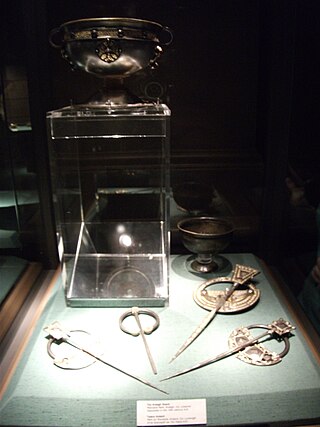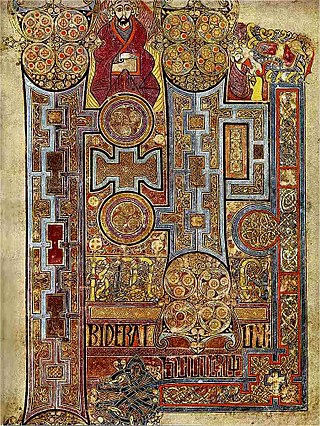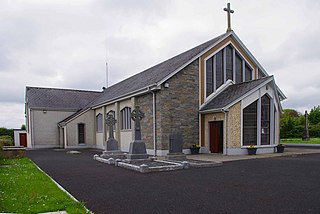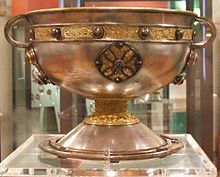
The Ardagh Hoard, best known for the Ardagh Chalice, is a hoard of metalwork from the 8th and 9th centuries. Found in 1868 by two young local boys, Jim Quin and Paddy Flanagan, it is now on display in the National Museum of Ireland in Dublin. It consists of the chalice, a much plainer stemmed cup in copper-alloy, and four brooches — three elaborate pseudo-penannular ones, and one a true pennanular brooch of the thistle type; this is the latest object in the hoard, and suggests it may have been deposited around 900 AD.

Ringforts or ring forts are small circular fortified settlements built during the Bronze Age, Iron Age and early Middle Ages up to about the year 1000 AD. They are found in Northern Europe, especially in Ireland. There are also many in South Wales and in Cornwall, where they are called rounds. Ringforts come in many sizes and may be made of stone or earth. Earthen ringforts would have been marked by a circular rampart, often with a stakewall. Both stone and earthen ringforts would generally have had at least one building inside.

The Derrynaflan Chalice is an 8th- or 9th-century chalice that was found as part of the Derrynaflan Hoard of five liturgical vessels. The discovery was made on 17 February 1980 near Killenaule, County Tipperary in Ireland. According to art historian Michael Ryan the hoard "represents the most complex and sumptuous expression of the ecclesiastical art-style of early-medieval Ireland as we know it in its eighth- and ninth-century maturity." The area known as Derrynaflan is an island of pastureland surrounded by bogland, which was the site of an early Irish abbey. The chalice was found with a composite silver paten, a hoop that may have been a stand for the paten, a liturgical strainer and a bronze basin inverted over the other objects. The group is among the most important surviving examples of Insular metalwork. It was donated to the Irish State and the items are now on display in the National Museum of Ireland.

The Grianan of Aileach, sometimes anglicised as Greenan Ely or Greenan Fort, is a hillfort atop the 244 metres (801 ft) high Greenan Mountain at Inishowen in County Donegal, Ireland. The main structure is a stone ringfort, thought to have been built by the Northern Uí Néill, in the sixth or seventh century CE; although there is evidence that the site had been in use before the fort was built. It has been identified as the seat of the Kingdom of Ailech and one of the royal sites of Gaelic Ireland. The wall is about 4.5 metres (15 ft) thick and 5 metres (16 ft) high. Inside it has three terraces, which are linked by steps, and two long passages within it. Originally, there would have been buildings inside the ringfort. Just outside it are the remains of a well and a tumulus.

Insular art, also known as Hiberno-Saxon art, was produced in the post-Roman era of Great Britain and Ireland. The term derives from insula, the Latin term for "island"; in this period Britain and Ireland shared a largely common style different from that of the rest of Europe. Art historians usually group Insular art as part of the Migration Period art movement as well as Early Medieval Western art, and it is the combination of these two traditions that gives the style its special character.
Ressad or Ress refers to a now lost city and possibly also to a territory that is still unidentified but believed by scholars to have been somewhere within the borders of modern County Limerick in western Ireland, in what was once the territory of the kingdom of the Uí Fidgenti.

Ardagh is a village and civil parish in County Limerick, Ireland. The village is situated round the junctions of the R523 and R521 roads. The nearest town is Newcastle West, 5 kilometres (3 mi) to the south. Primary level education for the village and its surroundings is provided by St Molua's National School. The parish is bounded to the west by Athea, to the north by the parish of Coolcappa, to the east Rathkeale and to the south by Newcastle West. The local GAA club is St. Kierans which represents both the parish of Ardagh-Carrigkerry as well as Coolcappagh-Kilcolman.
Mullaghreelan Rath is a ringfort (rath) and National Monument located in County Kildare, Ireland.
Lisnaran Fort is a ringfort (rath) and National Monument located in County Louth, Ireland.
Drummin fort is a ringfort and National Monument located in County Roscommon, Ireland.
Rathsoony is a ringfort and national monument located in County Galway, Ireland.

Cashlaungar, also Cashlaungarr, Cashlaun Gar or Cashlán Gar, is a stone ringfort (cashel) and National Monument located in The Burren, a region in County Clare, Ireland.
Carntierna is a ringfort and National Monument located in County Cork, Ireland.
Cahervagliar is a ringfort (rath) and National Monument (#233) located in County Cork, Ireland.
The Cush Earthworks are a series of earthworks, and a National Monument, located in County Limerick, Ireland.

Loher Cashel is a stone ringfort (cashel) and National Monument located on the Iveragh Peninsula, Ireland.

Annagh Church is a medieval church and National Monument in County Kerry, Ireland.
Caheravoley Fort is a ringfort (rath) and bawn forming a national monument located in County Galway, Ireland.
Ballynavenooragh is a stone fort and National Monument located in County Kerry, Ireland.










